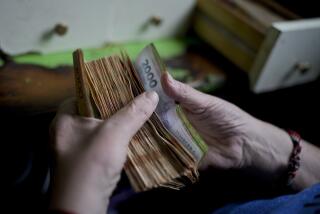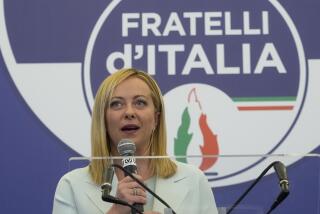Italy Seeks to Revalue Lira, Putting It on Par With Other Key Currencies
- Share via
ROME — A 40-year-old dream of bringing arithmetical simplicity to the Italian lira is being revived here as a celebration of national economic maturity.
The government of Prime Minister Giovanni Goria proposes to remove three awkward zeroes from the lira.
Zero-stripping is most common in Latin America, where it is often required by runaway inflation. In Italy, in contrast, the Goria government argues that economic stability and the conquest of inflation are the reasons that it is possible.
Under the plan, which requires parliamentary approval and is at least a year from implementation, one so-called heavy lira would replace 1,000 current lire. That would bring Italy’s exchange rate into line with those of other West European countries.
If the move were carried out today, the lira would go from 1,240 to the dollar to 1.24, making it roughly comparable to the Swiss franc, the West German mark and the British pound.
‘Irrationality’ Attacked
Treasury Minister Giuliano Amato won quick Cabinet approval of the plan over the weekend, attacking “the irrationality of a monetary system in which the basic unit is practically nonexistent . . . forcing people to reason in terms of thousands, hundreds of thousands and millions of monetary units.”
The single lira has long since disappeared from Italian daily life. Coins of 5, 10 and 20 lire exist but are seldom seen and virtually unusable. The 50-lire coin is the smallest in wide circulation--in a country where a tiny cup of coffee costs 600 lire, a bus ticket 700 and a newspaper 800.
Under the new system, the strong lira would have 100 cents, or centesimi, making the coffee 60 cents and the paper 80 cents.
Echoing longstanding complaints, Amato said the current level of the lira complicates daily life and bookkeeping for everyone, from housewives to large companies to the state.
“It contrasts with the image of a modern developed country that Italy has earned for itself,” he said, asserting that, in a strong economy, the new lira will maintain its value.
Italy’s inflation last year was around 5%.
The government’s real growth projections this year are 2% to 2.5% for a country that is amicably bickering with France and Britain over which has the largest economy among industrialized countries after the United States, Japan and West Germany.
Although planners expect a psychological backlash from Italians who think that it will make them “feel poor,” initial reaction to the proposed reform seems to be favorable.
‘Justice Is Done’
Corrado Giustiniani, financial columnist in the Rome newspaper Il Messagero, exulted: “Brothers of Italy, justice is done. With eight articles of law, they have canceled not only three zeroes from the present 1,000 lire, but also the shame of a humiliation.”
Giustiniani noted that, out of 163 world currencies, only a handful have a unit value lower than the lira.
Talk of monetary reform has come up regularly almost since the end of World War II, only to be short-circuited by bouts of inflation and governmental instability.
The last serious effort died last year with the collapse of a government led by Socialist Prime Minister Bettino Craxi, who had Goria as his Treasury minister.
Although no organized opposition to it is apparent, the current effort is vulnerable to the weakness of the Goria government, which could fall before Parliament gets around to approving the measure.
More to Read
Sign up for Essential California
The most important California stories and recommendations in your inbox every morning.
You may occasionally receive promotional content from the Los Angeles Times.













